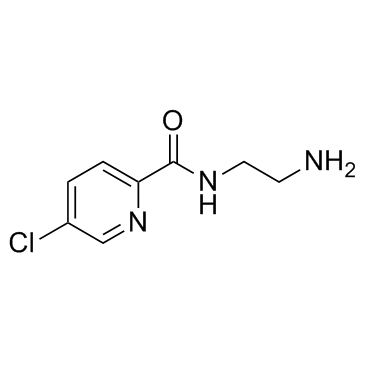Lazabemide (Ro 19-6327) (Synonyms: Ro 19-6327/000) |
| Catalog No.GC30979 |
Le lazabémide (Ro 19-6327) (Ro 19-6327) est un inhibiteur sélectif et réversible de la monoamine oxydase B (MAO-B) (IC50=0,03 μM) mais moins actif pour la MAO-A (IC50>100 μM ).
Products are for research use only. Not for human use. We do not sell to patients.

Cas No.: 103878-84-8
Sample solution is provided at 25 µL, 10mM.
Lazabemide(Ro 19-6327) is selective, reversible monoamine oxidase B (MAO-B) inhibitor (IC50 values are 0.03 and > 100 μM for MAO-B and MAO-A respectively).
The in vitro binding characteristics of both radiolabeled inhibitors revealed them to be selective, high-affinity ligands for the respective enzymes. KD and Bmax values for 3H-Ro 41-1049 in rat cerebral cortex were 10.7 nM and 7.38 pmol/mg protein, respectively, and for 3H-Ro 19-6327 were 18.4 nM and 3.45 pmol/mg protein, respectively[1]. The IC50 values for lazabemide and Ro 16-6491, respectively, were: 86 microM and 90 microM for NA uptake; 123 microM and 90 microM for 5HT uptake; > 500 microM and > 1000 microM for DA uptake. Lazabemide and Ro 16-6491 also differed from L-deprenyl in their ability to induce release of endogenous monoamines from synaptosomes. Thus, Lazabemide(Ro 19-6327) (500 microM) induced a greater 5 HT release than did L-deprenyl, but was less effective than L-deprenyl in releasing DA. On the contrary, lazabemide was almost completely inactive on either 5 HT and DA release[2]. a clear inhibition of DOPAC formation was observed with Lazabemide(Ro 19-6327) (250 nM), while 250 nM lazabemide was found not to increase the accumulation of newly-formed DA in those tubular epithelial cells loaded with 50 microM L-DOPA[3].
The ischemia reperfusion-induced hydroxyl radical generation was attenuated by 3 mg/kg of clorgyline and lazabemide. Furthermore, mice pretreated with these MAO inhibitors showed decreased DOPAC levels in comparison with those of their respective vehicle-treated control groups; recovery of the reduced DOPAC level was also delayed[4].
[1]. Saura J, et al. Quantitative enzyme radioautography with 3H-Ro 41-1049 and 3H-Ro 19-6327 in vitro: localization and abundance of MAO-A and MAO-B in rat CNS, peripheral organs, and human brain. J Neurosci. 1992 May;12(5):1977-99. [2]. Bondiolotti GP, et al. In vitro effects on monoamine uptake and release by the reversible monoamine oxidase-B inhibitors lazabemide and N-(2-aminoethyl)-p-chlorobenzamide: a comparison with L-deprenyl. Biochem Pharmacol. 1995 Jun 29;50(1):97-102. [3]. Guimaraes J, et al. The activity of MAO A and B in rat renal cells and tubules. Life Sci. 1998;62(8):727-37. [4]. Suzuki T, et al. MAO inhibitors, clorgyline and lazabemide, prevent hydroxyl radical generation caused by brain ischemia/reperfusion in mice. Pharmacology. 1995 Jun;50(6):357-62.
Average Rating: 5 (Based on Reviews and 5 reference(s) in Google Scholar.)
GLPBIO products are for RESEARCH USE ONLY. Please make sure your review or question is research based.
Required fields are marked with *




















